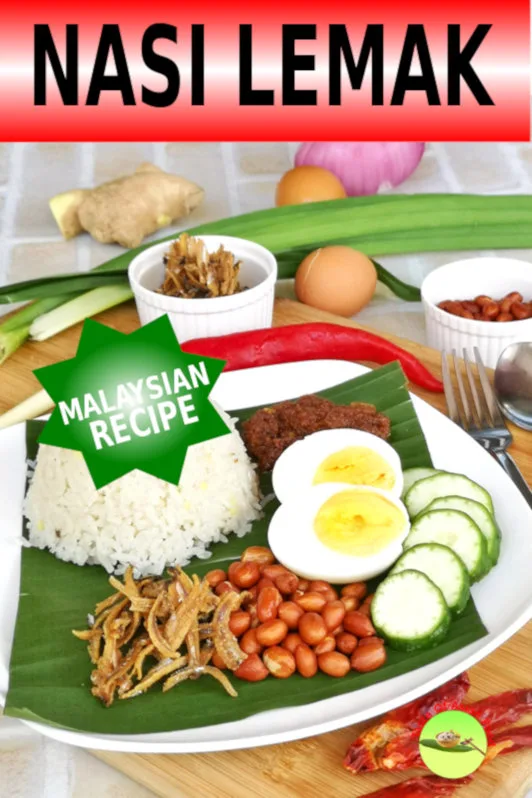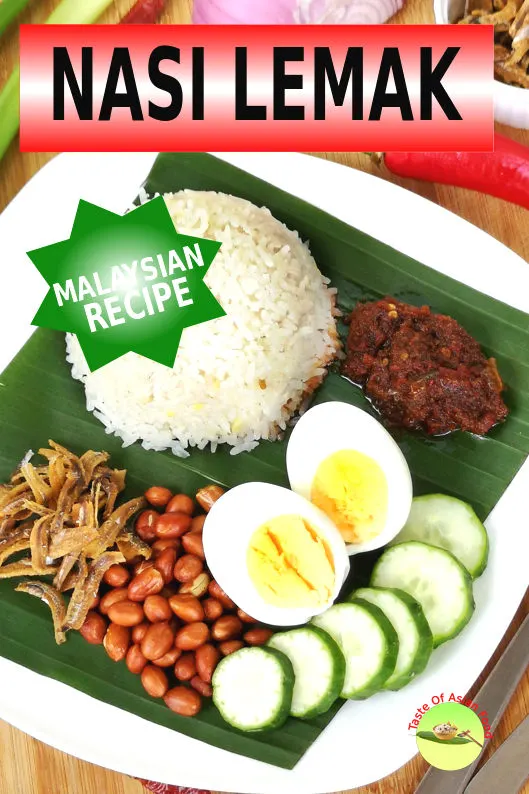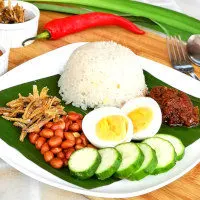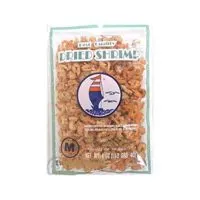Nasi Lemak (椰漿飯) is Malaysia’s ultimate breakfast (and lunch!) staple. Fragrant coconut milk rice served with spicy sambal, crispy anchovies, and crunchy peanuts, all beautifully wrapped in banana leaves. It’s a dish you can find in almost every Malay and Mamak eatery, and one that locals never get tired of!
When we ran our restaurant, nasi lemak was one of our best-selling dishes. Our customers loved its rich aroma and the perfect balance of flavors.
In this post, I’m excited to share the very recipe that made it a crowd favorite at our restaurant, now refined and simplified for home cooks.
This is our special version. It is authentic, comforting, and packed with the same delicious flavor that kept our guests coming back for more.

Note: This post may contain affiliate links. Please read my privacy policy for more info. I may receive commissions for purchases made through links in this post. As an Amazon Associate, I earn from qualifying purchases.
What is Nasi Lemak?
For Malaysians and Singaporeans, nasi lemak needs no introduction. But for those outside the region, this dish is truly the heart and soul of our breakfast culture.
The name nasi lemak literally means “creamy rice” in Malay, a nod to the rich aroma of rice cooked with coconut milk, pandan (screwpine) leaves, ginger, and onions. The ingredients are simple, yet when you cook the rice with chicken stock instead of plain water, the flavor becomes incredibly fragrant and flavorful.
A classic plate of nasi lemak comes with all the must-haves: spicy sambal (chili paste), crispy ikan bilis (fried anchovies), hard-boiled egg, roasted peanuts, and fresh cucumber slices.
How to Cook Nasi Lemak (Coconut Milk Rice)
Each part of this dish can be prepared separately. In the following sections, I’ll show you how to cook the fragrant coconut milk rice, followed by the spicy sambal (chili paste), and finally, all the delicious accompaniments that complete this iconic dish.
1. Cook the Rice
Ingredients
- 250g (8.8 oz) long-grain rice
- 150ml (5.3 oz) coconut milk
- 150ml (5.3 oz) chicken stock
- 125ml (½ cup) water
- 2 pandan leaves, knotted
- 1 lemongrass stalk, bashed
- 1 tsp minced ginger
- 1 tbsp chopped onion
- ½ tsp (2.5g) salt
- ½ tsp fenugreek seeds
Method
- Rinse the rice once or twice until the water runs mostly clear. Do not over-rinse, as a small amount of starch helps the rice stay creamy.
- Drain the rice thoroughly and transfer it to a rice cooker or heavy-bottomed pot.
- Add aromatics: pandan leaves, lemongrass, minced ginger, chopped onion, salt, and fenugreek.
- Combine coconut milk, chicken stock, and water in a bowl, then pour the mixture over the rice.
- Cook the rice in a rice cooker or on the stovetop. If using the stovetop, bring it to a gentle simmer, cover, and cook over low heat until all the liquid is absorbed and the rice is tender.
- Let the rice sit covered for 10 minutes, then gently fluff it with a fork or rice paddle to separate the grains.
Tips:
- For the best flavor, use fresh coconut milk, which gives the rice a richer aroma and a naturally creamy texture. If fresh coconut milk isn’t available, packaged or dehydrated coconut milk works well too. Just follow the instructions on the package to reconstitute it properly.
- A small amount of fenugreek seeds is my secret ingredient. It adds enhances the fragrance of the rice wonderfully.
- In many restaurants, chefs often add chicken powder or bouillon to boost the umami flavor. If you prefer not to use these, simply increase the salt slightly or replace part of the water with chicken broth.
2. How to make sambal for nasi lemak
This sambal is specially created just for nasi lemak. In Malay, sambal simply means chili paste, and it’s the most essential part of the dish besides the fragrant coconut rice itself.
Ingredients A
- 200g (7 oz) onions
- 50g (1.7 oz) garlic
- 75ml (5 tbsp) cooking oil (or enough to blend smoothly)
Ingredients B (blend)
- 150g (5.3 oz) red chilies, deseeded and cut into small pieces
- 25g (1 oz) dried chilies, soaked until soft and drained
- 30g (4 tbsp) dried shrimps, soaked in hot water for 20 minutes and drained
- 75ml (5 tbsp) cooking oil
Ingredients C
- 37g (2½ tbsp) palm sugar
- 1 tbsp tamarind pulp, soaked in ¼ cup hot water and strained for juice
- 100g (3.5 oz) onion, thinly sliced
- 50ml (1.7 oz) cooking oil (to add later)
- 4g (¾ tsp) salt
Method
- Blend the onions and garlic with oil (A) until smooth. Avoid adding water when blending, as it will extend the time needed to caramelize the onions later. Add just enough oil for the blender to run smoothly.
- Transfer the blended onion mixture to a wok or pan and sauté over low heat until it turns golden brown and caramelized (about 10 minutes).
- Cut the dried chilies into short sections and remove the seeds, as uncrushed seeds will remain visible in the sambal. Boil the dried chilies for 10–15 minutes until soft, then drain. Remove the seeds from the fresh red chilies and cut them into pieces.
- Blend the softened dried chilies, fresh chilies, and soaked dried shrimp with the oil (B) until you get a smooth paste.
- Add the blended chili paste to the caramelized onion mixture in the wok. Simmer gently over low to medium heat for about 30 minutes, stirring frequently. The paste will gradually thicken; if it becomes too dry, add a splash of water.
- Stir in the sliced onions, tamarind juice, palm sugar, and salt (C).
- Add the remaining 50ml of oil and continue to simmer for another 30 minutes or longer. The sambal is ready when it turns dark red, glossy, and the oil separates from the paste.
Tips for Making Sambal
- Use Indian onions for the best flavor. They are naturally sweeter than yellow onions and help balance the heat and tanginess of the chilies.
- Use oil, not water, when blending. Oil helps the blender run smoothly and prevents excess moisture, which would otherwise extend the cooking time. Sambal needs plenty of oil to achieve its rich, glossy finish.
- Don’t worry about excess oil. After cooking, you can remove any oil floating on the surface. Keep this flavorful oil for frying eggs, stir-frying noodles (like mee goreng), or enriching your next batch of sambal.
- Cook it low and slow. Simmer the sambal to evaporate most of the water and allow the flavors to deepen. Properly reduced sambal keeps well at room temperature for 3–4 days or can be frozen for several months without losing flavor.
- You can add fried anchovies (ikan bilis) toward the end to create sambal ikan bilis. However, I prefer serving the fried anchovies separately alongside the nasi lemak for better texture contrast.

3. Preparing the Accompaniments
Now that the rice and sambal are ready, you’re already halfway to a delicious plate of nasi lemak! The sambal can be made in advance as it keeps well in the fridge for up to a week, or you can freeze it for a few months without losing its aroma and flavor. The rice, however, is best cooked right before serving so it stays warm and fluffy.
In the next section, let’s prepare the classic accompaniments that complete this beloved dish: fried anchovies (ikan bilis), hard-boiled eggs, and fried groundnuts (peanuts). These can all be prepared ahead of time. Here’s how to do each briefly:
a. Fried Groundnuts (Peanuts)
You can either lightly fry them in a pan with a small amount of oil or toast them in the oven until they turn golden and fragrant.
Once cooled, store the peanuts in an airtight container. They’ll stay fresh and crunchy for several weeks. It’s always more efficient to make a bigger batch since they keep so well. Plus, they make a great snack on their own or can be used in other dishes anytime you need a little crunch.
b. Fried Anchovies (Ikan Bilis)
Though simple to prepare, this step deserves some attention.
Heat enough oil in a wok or pan to fully submerge the anchovies. Once the oil is hot, deep-fry them over medium heat until they turn golden brown and crispy. You’ll know they’re ready when the oil stops popping and tiny bubbles form around the anchovies. This usually takes about five minutes.
Remove and drain them on paper towels, then let them cool completely before storing. If you’re not serving them right away, keep the fried anchovies in an airtight container to preserve their crispiness.
3. Hard-Boiled Eggs
The final classic accompaniment for nasi lemak is the humble hard-boiled egg. We have a complete guide on how to make perfect hard-boiled eggs on this blog, but here’s a quick summary:
Bring a pot of water to a boil and fully submerge the eggs. Lower the heat to maintain a gentle simmer with only small bubbles to rise. Cook for 16 minutes for firm, hard-boiled eggs, or 8 minutes if you prefer a soft-centered yolk.
Once done, immediately transfer the eggs into ice water to stop the cooking process and make peeling easier. When cooled, peel, slice, and serve them alongside the nasi lemak.
Assembling the Perfect Nasi Lemak
Now comes the most satisfying part, bringing everything together!
Start by placing a generous scoop of warm coconut milk rice in the center of your plate (or on a piece of banana leaf for that authentic aroma. Add a serving of sambal on the side, then arrange the fried anchovies, crispy groundnuts, cucumber slices, and half a hard-boiled egg neatly around the rice.
For a more indulgent version, you can serve it with chicken curry, sambal prawns, beef rendang, or fried chicken to make the meal even more complete.

Nasi Lemak
Nasi Lemak 椰漿飯 is the breakfast and lunch staple in Malaysia. This drool-worthy, gluttonous gem is offered in almost every local Malay and Mamak restaurant. Wrapped in paper and banana leaves, this Nasi Lemak Bungkus (wrapped coconut milk rice) has become the quintessential breakfast for the locals.
Ingredients
Nasi Lemak:
- 250g (8.8 oz) Long grain rice
- 150ml (5.3 oz) coconut milk
- 150ml (5.3 oz) chicken stock
- 125ml (half cup) water
- 2 pandan leaves
- 1 lemongrass, bashed
- 1tsp minced ginger
- 1 tbsp chopped onion
- 1/2 tsp (2.5g) sslt
- 1/2 tsp fenugreek
Sambal
- Ingredients A:
- 200g (7oz) of onions
- 50g (1.7 oz) of garlic
- 75m (5 tbsp) cooking oil or sufficient to blend smoothly.
- Ingredients B:
- 150 g (5.3 oz) red chilies
- 25g (1 oz) dried chili
- 30g (4 tbsp) dried shrimps, soaked for 20 minutes
- 75ml (5 tbsp) cooking oil
- Ingredients C:
- 75ml (5 tbsp) cooking oil
- Ingredients D:
- 37g (2.5 tbsp) palm sugar
- 1 tbsp tamarind pulp, soak in 1/4 cup of hot water
- 100g (3.5 oz) onion, sliced
- 50ml (1.7 oz) cooking oil add to the sambal
- 4g (3/4 tsp) salt
Others:
- 30 g groundnuts
- 30 g anchovies
- 1 hard-boiled egg
- Few slices of cucumbers
Instructions
For the rice:
- Rinse the rice. Remove as much water as possible.
- Add all the ingredients into the rice cooker.
- Pour the liquid into the rice cooker and that is.
For the sambal:
- Blend the onions and garlic with sufficient oil.
- Saute the onion paste until it caramelized.
- Remove the seeds from the dried chili, then boiled in water until it turns soft.
- Soak the dried shrimps with water for 20 minutes.
- Add the dried, dried shrimps and red chili to the blender. Blend with sufficient oil.
- Add the chili paste to the caramelized onion. Simmer for half an hour.
- Add tamarind juice, palm sugar, and salt.
- Lastly, add the onions and cook until tender.
Others :
- Stir-fry the groundnuts until the color darkens slightly.
- Deep-fried the anchovies until crispy.
- Cut the half boiled egg into two.
- Cut the tomato and cucumber into slices.
Recommended Products
As an Amazon Associate and member of other affiliate programs, I earn from qualifying purchases.
-
 Tamicon Tamarind Paste
Tamicon Tamarind Paste -
 Dried shrimp - 3 oz
Dried shrimp - 3 oz -
Soeos Szechuan Dried Chili,Dry Szechuan Pepper, Dry Chile Peppers, Sichuan Pepper, Dried Red Chilies, 4oz, (Very Mild Spicy)
-
 Instant Pot DUO60 6 Qt 7-in-1 Multi-Use Programmable Pressure Cooker, Slow Cooker, Rice Cooker, Steamer, Sauté, Yogurt Maker and Warmer
Instant Pot DUO60 6 Qt 7-in-1 Multi-Use Programmable Pressure Cooker, Slow Cooker, Rice Cooker, Steamer, Sauté, Yogurt Maker and Warmer -
 Joyce Chen 21-9972, Classic Series Carbon Steel Wok Set, 4-Piece, 14-Inch Charcoal
Joyce Chen 21-9972, Classic Series Carbon Steel Wok Set, 4-Piece, 14-Inch Charcoal
Nutrition Information:
Yield: 3 Serving Size: 3 servingsAmount Per Serving: Calories: 1536Total Fat: 41gSaturated Fat: 8gTrans Fat: 0gUnsaturated Fat: 27gCholesterol: 184mgSodium: 1715mgCarbohydrates: 259gFiber: 36gSugar: 122gProtein: 77g
This data was provided and calculated by Nutritionix on 11/1/2019

Diane T
Friday 21st of November 2025
Please answer my burning question! Do you need to give the ikan bilis a wash before frying it?
KP Kwan
Friday 21st of November 2025
I usually just wipe it with a dry cloth. If it gets really dirty, I’ll give it a quick rinse (just a few seconds) and then let it air-dry at room temperature before frying.
Josefa
Sunday 2nd of November 2025
Hi JP, i thorougly enjoy your recipes, Could you create a vegie version, no shrimps in the sambal and no enchovies. I know it´s not the same but ja, vegies want Nasi Lemak too. Also, I live in South Africa currently - there is no Pandan leaves.....:-(
KP Kwan
Tuesday 4th of November 2025
I completely understand your concern. Pandan leaves are optional, even some locals make nasi lemak without them.
As for the shrimp, you can simply leave it out when making the sambal (chili paste). If you don’t want anchovies, you can substitute them with fresh cucumber slices.
How to Make Malaysian Chicken Rendang — Step-by-Step Recipe
Friday 31st of October 2025
[…] now you have completed the chicken rendang. You can serve it with nasi lemak, biryani rice, or just white […]
How to Make Belacan Fried Chicken - Easy Malaysian Recipe
Saturday 29th of March 2025
[…] cucumber slices, and sambal belacan (a spicy shrimp paste dip). It also pairs wonderfully with nasi lemak, one of Malaysia’s most popular […]
Ayam goreng - How to make authentic Malaysian fried chicken
Friday 1st of November 2024
[…] Nasi Lemak is the breakfast staple in Malaysia. This drool-worthy, gluttonous gem is offered in almost every local Malay and Mamak restaurant. It’s rice cooked with coconut milk and spices. […]